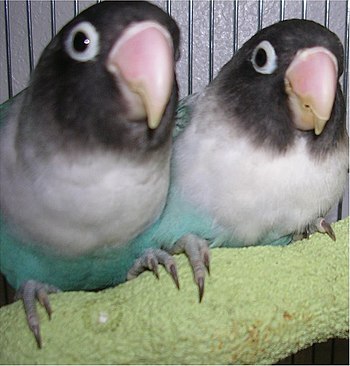| A pet Cockatiel standing by the open cage door. (Photo credit: Wikipedia) |
| English: Cockatiel, Nymphicus hollandicus and Budgerigar, Melopsittacus undulatus fighting on a perch. (Photo credit: Wikipedia) |
How to
Prevent Accidents and Illness in Your Pet Cockatiel
Preventing accidents
and illness with your cockatiel just takes a little forethought. When
purchasing a treats and toys carefully look at them as you would for something
you were buying a younger child. Not all birds' toys are created equal.
Consider if metal or plastic parts will come loose with your cockatiel is
playing with it. If your bird is particularly aggressive with toys you will
want to make sure you purchase toys that do not have parts that will come loose
when stressed by the bird's beak.
You also need to look over any environment that you plan
to let your cockatiel loose in .
You will need to look at the room with the eyes of a small
curious child who happens to be able to fly and climb. Make sure doors and
windows are shut. Make sure the family cat is out of the room. Cabinets and
tight enclosed areas should be covered to avoid having your curious bird get
stuck in them. Your bird may have issues with windows if they are not used to
them. Pull the shades; until you know your cockatiel knows that the window is
not an open door to the outside. The best rule of thumb is to never leave your
bird unsupervised for even a short period of time.
Preventing illness in your pet cockatiel really centers on
cleanliness. You need to change the papers in the bottom of the cage daily. You
should once a week the bottom tray; should be washed with a mild soap and hot
water. Some people advocate using disinfectant. Strong fumes can be dangerous
to your bird, so only use strong disinfectant in another room and rise the tray
several times to make sure your cockatiel has not exposure to the chemicals.
When you wash the tray weekly; also wash toys, food dishes, and removable
perches. If you bird has made an obvious mesh on a perch just wipe it off with
a damp paper towel during your daily cleaning. It is a good habit to rinse
water and food dishes and dry them out every time you feed. Daily eminence
makes weekly clean up a breeze.
Your bird benefits from bathing as well. The best thing to
do is simply put a shallow bowl in bottom of the cage for a half hour a couple
of times a week. Most cockatiels will bathe themselves. Some people bath their
birds with the sprayer in the kitchen sink. This is fine if your bird will not
take off and get into trouble in the middle of a bath and you can absolutely control
the water temperature. Water that is too hot will kill your bird. You also must
be sure the room is free of drafts when you bath your bird. An alternative to a
shower is a spray bottle bath. These are fine if your cockatiel is not stressed
by the spray bottle as many birds are.
Feeding your cockatiel a good diet, accident prevention,
and cage cleanliness will assure that your bird suffers from very few accidents
and illness. It is also a good idea to provide you bird with some climbing toys
to be a proper amount of excursive when you can not have them outside the cage.
Change the drinking water often especially, if you have more than one bird in
the cage as no one wants to drink toilet water and they will contaminate the
water dish over the course of the day.
Your bird can live a healthy life for years with a little
common sense and effort on your part.






























